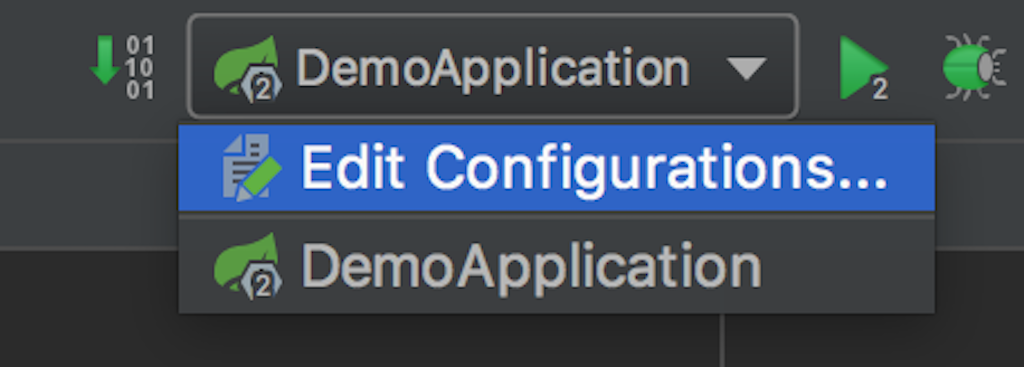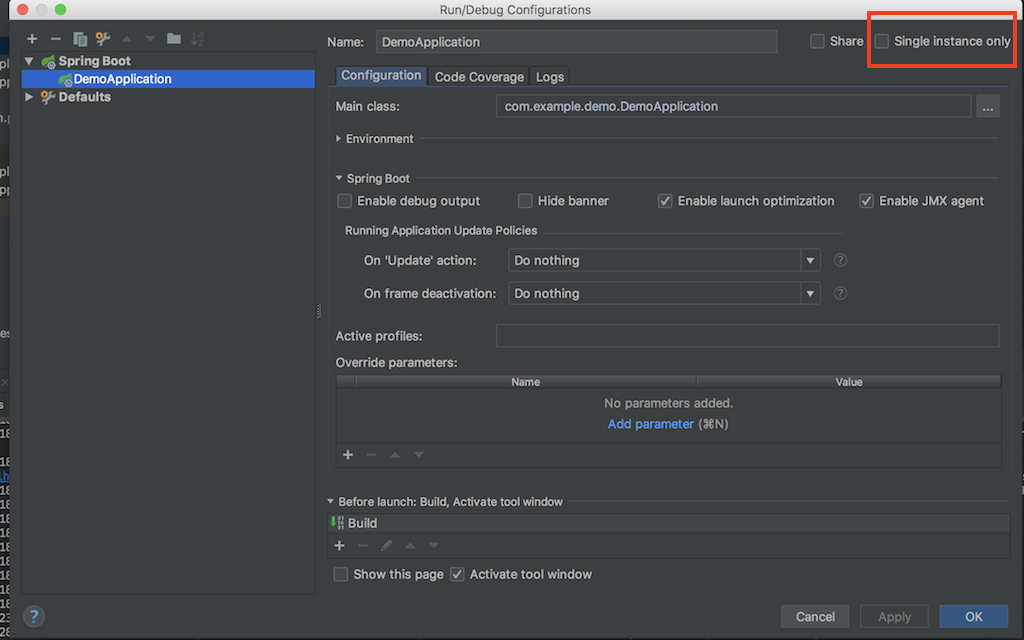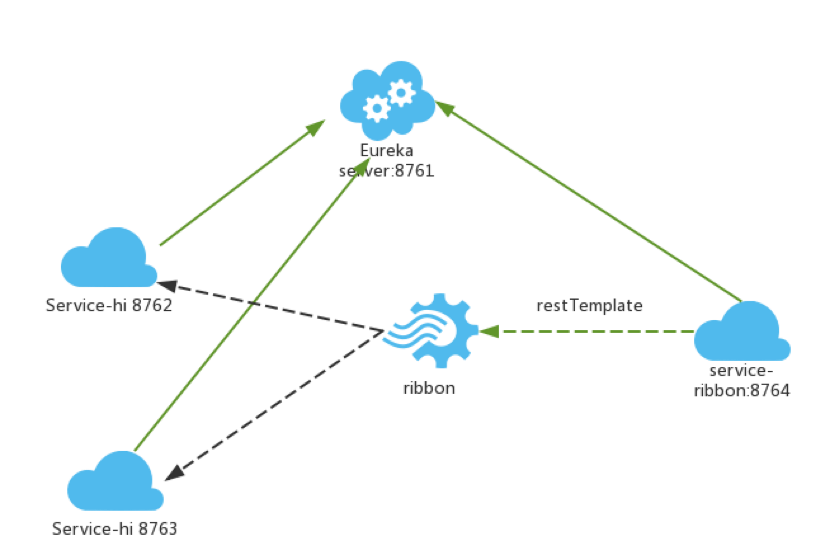在微服务架构中,业务都会被拆分成一个独立的服务,服务与服务的通讯是基于http restful的。Spring cloud有两种服务调用方式,一种是ribbon+restTemplate,另一种是feign。
Ribbon是Netflix发布的开源项目,主要功能是提供客户端的软件负载均衡算法,将Netflix的中间层服务连接在一起。Ribbon客户端组件提供一系列完善的配置项如连接超时,重试等。简单的说,就是在配置文件中列出Load Balancer(简称LB)后面所有的机器,Ribbon会自动的帮助你基于某种规则(如简单轮询,随即连接等)去连接这些机器。我们也很容易使用Ribbon实现自定义的负载均衡算法。
Ribbon提供的主要负载均衡策略:
1:简单轮询负载均衡(RoundRobin)
以轮询的方式依次将请求调度不同的服务器,即每次调度执行i = (i + 1) mod n,并选出第i台服务器。
2:随机负载均衡 (Random)
随机选择状态为UP的Server
3:加权响应时间负载均衡 (WeightedResponseTime)
根据相应时间分配一个weight,相应时间越长,weight越小,被选中的可能性越低。
4:区域感知轮询负载均衡(ZoneAvoidanceRule)
复合判断server所在区域的性能和server的可用性选择server
ribbon 已经默认实现了这些配置bean:
-
IClientConfig ribbonClientConfig: DefaultClientConfigImpl
-
IRule ribbonRule: ZoneAvoidanceRule
-
IPing ribbonPing: NoOpPing
-
ServerList ribbonServerList: ConfigurationBasedServerList
-
ServerListFilter ribbonServerListFilter: ZonePreferenceServerListFilter
-
ILoadBalancer ribbonLoadBalancer: ZoneAwareLoadBalancer
一、
启动eureka-server 工程;
启动service-hi工程,它的端口为8762;
将service-hi的配置文件的端口改为8763,并启动,这时你会发现:service-hi在eureka-server注册了2个实例,这就相当于一个小的集群。访问localhost:8761如图所示:

注:如何同时启动多个实例?


把那个single instance only的勾去掉
多个实例,需要多个端口,分别启动。
二、创建服务消费者
像之前那样建立一个工程,pom.xml配置如下:
<?xml version="1.0" encoding="UTF-8"?> <project xmlns="http://maven.apache.org/POM/4.0.0" xmlns:xsi="http://www.w3.org/2001/XMLSchema-instance" xsi:schemaLocation="http://maven.apache.org/POM/4.0.0 http://maven.apache.org/xsd/maven-4.0.0.xsd"> <modelVersion>4.0.0</modelVersion> <groupId>com.example</groupId> <artifactId>service-ribbon</artifactId> <version>0.0.1-SNAPSHOT</version> <packaging>jar</packaging> <name>service-ribbon</name> <description>Demo project for Spring Boot</description> <parent> <groupId>org.springframework.boot</groupId> <artifactId>spring-boot-starter-parent</artifactId> <version>2.0.3.RELEASE</version> <relativePath/> <!-- lookup parent from repository --> </parent> <properties> <project.build.sourceEncoding>UTF-8</project.build.sourceEncoding> <project.reporting.outputEncoding>UTF-8</project.reporting.outputEncoding> <java.version>1.8</java.version> <spring-cloud.version>Finchley.RELEASE</spring-cloud.version> </properties> <dependencies> <dependency> <groupId>org.springframework.cloud</groupId> <artifactId>spring-cloud-starter-netflix-eureka-server</artifactId> </dependency> <dependency> <groupId>org.springframework.cloud</groupId> <artifactId>spring-cloud-starter-netflix-eureka-client</artifactId> </dependency> <dependency> <groupId>org.springframework.cloud</groupId> <artifactId>spring-cloud-starter-ribbon</artifactId> </dependency> <dependency> <groupId>org.springframework.boot</groupId> <artifactId>spring-boot-starter-web</artifactId> </dependency> <dependency> <groupId>org.springframework.boot</groupId> <artifactId>spring-boot-starter-test</artifactId> <scope>test</scope> </dependency> </dependencies> <dependencyManagement> <dependencies> <dependency> <groupId>org.springframework.cloud</groupId> <artifactId>spring-cloud-dependencies</artifactId> <version>${spring-cloud.version}</version> <type>pom</type> <scope>import</scope> </dependency> </dependencies> </dependencyManagement> <build> <plugins> <plugin> <groupId>org.springframework.boot</groupId> <artifactId>spring-boot-maven-plugin</artifactId> </plugin> </plugins> </build> </project>
application.properties配置如下:
eureka.client.serviceUrl.defaultZone = http://localhost:8761/eureka/
server.port = 8764
spring.application.name = service-ribbon
在工程的启动类中,通过@EnableDiscoveryClient向服务中心注册;并且向程序的ioc注入一个bean: restTemplate;并通过@LoadBalanced注解表明这个restRemplate开启负载均衡的功能。
package com.example.serviceribbon; import org.springframework.boot.SpringApplication; import org.springframework.boot.autoconfigure.SpringBootApplication; import org.springframework.cloud.client.discovery.EnableDiscoveryClient; import org.springframework.cloud.client.loadbalancer.LoadBalanced; import org.springframework.context.annotation.Bean; import org.springframework.web.client.RestTemplate; @EnableDiscoveryClient @SpringBootApplication public class ServiceRibbonApplication { public static void main(String[] args) { SpringApplication.run(ServiceRibbonApplication.class, args); } @Bean @LoadBalanced RestTemplate restTemplate() { return new RestTemplate(); } }
写一个类HelloService,通过之前注入ioc容器的restTemplate来消费service-hi服务的“/hi”接口,在这里我们直接用的程序名替代了具体的url地址,在ribbon中它会根据服务名来选择具体的服务实例,根据服务实例在请求的时候会用具体的url替换掉服务名,代码如下:
package com.example.serviceribbon; import org.springframework.beans.factory.annotation.Autowired; import org.springframework.stereotype.Service; import org.springframework.web.client.RestTemplate; @Service public class HelloService { @Autowired RestTemplate restTemplate; public String hiService(String name) { return restTemplate.getForObject("http://SERVICE-HI/hi?name="+name,String.class); } }
写一个controller,在controller中用调用HelloService 的方法,代码如下
package com.example.serviceribbon; import org.springframework.beans.factory.annotation.Autowired; import org.springframework.web.bind.annotation.RequestMapping; import org.springframework.web.bind.annotation.RequestParam; import org.springframework.web.bind.annotation.RestController; @RestController public class HelloController { @Autowired HelloService helloService; @RequestMapping(value = "/hi") public String hi(@RequestParam String name){ return helloService.hiService(name); } }
在服务器上多次访问:http://localhost:8764/hi?name=mercy
结果如下:


这说明当我们通过调用restTemplate.getForObject(“http://SERVICE-HI/hi?name=“+name,String.class)方法时,已经做了负载均衡,访问了不同的端口的服务实例。
此时的架构如图:

- 一个服务注册中心,eureka server,端口为8761
- service-hi工程跑了两个实例,端口分别为8762,8763,分别向服务注册中心注册
- sercvice-ribbon端口为8764,向服务注册中心注册
- 当sercvice-ribbon通过restTemplate调用service-hi的hi接口时,因为用ribbon进行了负载均衡,会轮流的调用service-hi:8762和8763 两个端口的hi接口;